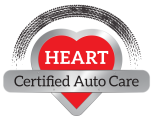Why is Your Check Engine Light On?
The check engine light. Is there a more mysterious auto part? What does it even mean when the check engine light is flashing? The short answer is that the check engine light goes on for anything from a minor issue to a catastrophic meltdown.
For a deeper understanding of why your check engine light is on, and to help you respond and prevent the need for a major auto repair, here are best practices for addressing check engine lights, as well as potential reasons why your check engine light may be on in the first place.
1. Is it Blinking or Solid?
Some check engine symbols blink to indicate an urgent situation, like fuel leaking into the exhaust system. If your check engine light is blinking, check the owner’s manual to see if your model offers specific tips. Either way, you’ll likely want to visit a car repair professional ASAP. If you need one you can trust, try HEART. We do 98% of our service same day.
2. Tighten Your Gas Cap
One of the most common reasons check engine lights illuminate is because your gas cap is too loose or cracked, which can lead to misreading of gauges and reduced fuel emissions. If your check engine light comes on, try tightening your gas cap and seeing if that solves the problem. If the light remains on a few drives later, bring your car down to HEART for our 33-point inspection.
3. Reduce Speed and/or Load
Sometimes check engine lights come on because the current load and speed combination is straining the car. If you’re driving and your dash lights up, slow down to let your car catch up. If not, consider visiting a car repair shop as soon as possible.
4. Any Other Lights?
Many vehicles will light up other icons to help you narrow down the check engine problem. If your car does, that’s great: you should look specifically for lights indicating low oil pressure, oil change, or overheating. If your car offers no further clues why your check engine light is on, do yourself a favor and go to HEART for a quick but comprehensive inspection.
5. Finally, here are some other, more serious reasons your check engine light may be on, many of which can lead to pricey car repairs.
– Broken Mass Airflow Sensor (MAS) — The mass airflow sensor measures engine air flow rate, regulating the gas accordingly. If the sensor’s broken, it can provide too much or too little fuel, throwing your whole system out of sync and leading to further — and costlier — auto repairs.
– Broken Oxygen Sensor — Along the same lines as the MAS, the oxygen sensor gauges how much oxygen is traveling into your engine. A broken sensor reduces fuel emissions and can lead to a cascade of problems, including damaged spark plugs.
– Malfunctioning spark plug — Speaking of… Luckily this is an easy fix and we at HEART can do this in less than a day.
– Broken Catalytic Converter — This auto part converts carbon monoxide into carbon dioxide, a key tool in reducing toxic gas emissions. A broken catalytic converter will reduce fuel efficiency and compromise engine reliability. If you need help, come by HEART, and we’ll have your car running like new in no time.
For more information on your check engine light or any other auto care question, call or stop by one of HEART Certified Auto Care’s three convenient Chicago area locations: HEART Northbrook, HEART Wilmette, or HEART Evanston.







